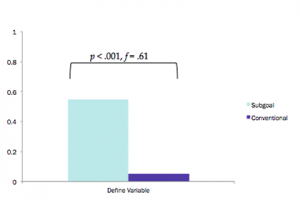Procedural instructions and worked examples have been shown to be effective learning aids in science, technology, engineering, and mathematics (STEM) learning materials. Procedural instructions are texts that describe a general method to reach a goal, while worked examples demonstrate how to apply this method to a specific instance. Research supporting the use of advanced organizers predicts that if learners see the worked example first, they can develop a basis for the problem-solving procedure. Learners can then use the procedural text to abstract their understanding, increasing both the initial and transfer performance.
Subgoals have been shown to increase novice performance when included in the procedural text and worked examples. A subgoal groups a set of solution steps by their purpose, which allows novice learners to create a framework for problem-solving. The proposed research investigates the potential interactions of instructional order and subgoal labeling on performance.

Located in the School of Psychology at the Georgia Institute of Technology, the Problem Solving and Educational Technology (PSET) Lab brings together a diverse group of faculty and students interested in an equally diverse range of topics. Students in the PSET Lab, under the direction of Dr. Richard Catrambone, are currently examining a range of problem solving and human-computer interaction issues.



